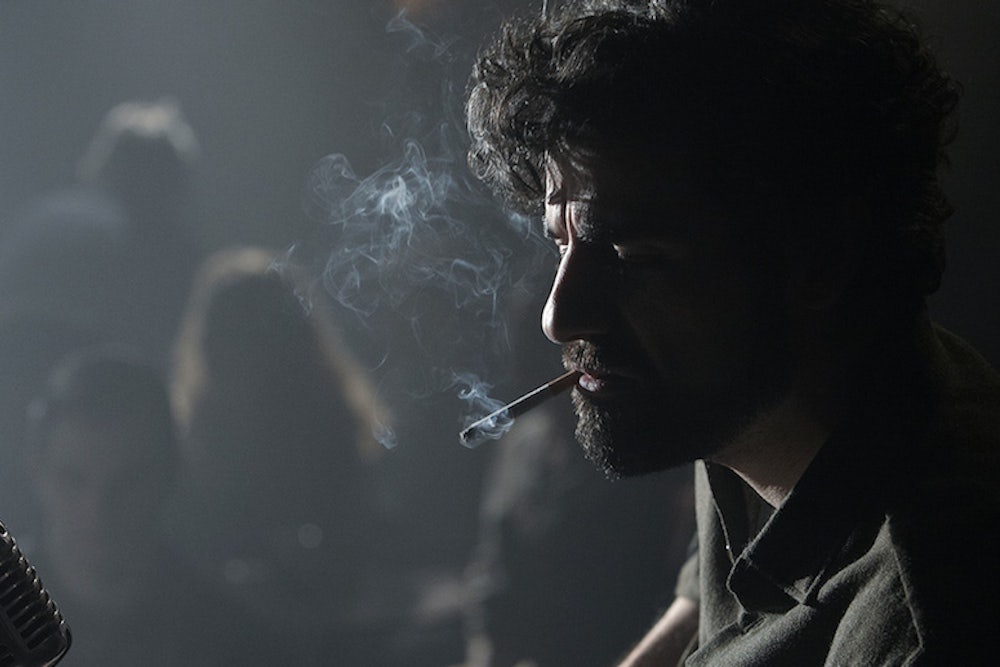Inside Llewyn Davis, the Coen brothers movie that opens for wider release Friday, is chockfull of folk songs—its subject is an obscure Greenwich Village-based folk singer loosely based on Dave Van Ronk. By far the most prominent is the old standard “Dink’s Song (Fare Thee Well).” We hear three different versions in the course of the movie: a slickly produced duet with two acoustic guitars, a mandolin, and a fiddle; an aborted solo on acoustic guitar; and a full-length solo on acoustic guitar. (The first and third recordings also appear on the soundtrack.) The differing arrangements actually rise to the level of a plot point.
“Dink’s Song” was “discovered” by the legendary ethnomusicologist John Lomax, who while traveling in Texas in 1904 heard a black woman named Dink singing a song, a capella, about a man who had left her. “Fare thee well, my honey, fare thee well,” is the song’s chorus. The song made its way into the folk mainstream in part via John’s son, Alan Lomax, a folklorist and performer who in the 1930s and ‘40s fell in with the folkies like Woody Guthrie and Pete Seeger who laid the groundwork for the folk revival of the 1960s—the period Inside Llewyn Davis depicts. The most famous performer to come out of the folk revival was Bob Dylan.
Sean Wilentz, a Princeton historian and the author of Bob Dylan In America, explains to me that “Dink’s Song” was an especially good choice both for folk performers and for the Coen brothers. (Wilentz also published an essay on Inside Llewyn Davis’ website and is a New Republic contributing editor.) For one thing: It’s easy! “Simple chords, nice to harmonize with, a man or a woman can sing it,” Wilentz notes. It is easily adaptable: While traditionally sung from the perspective of a woman (starting with Dink herself), many a man has sung it—sometimes keeping the female point-of-view, sometimes altering the lyrics. “A traditional singer would have had no problem singing a song from the opposite gender,” notes Norm Cohen, author of several books about folk music. In Inside Llewyn Davis, both versions are sung by men, but the first version is sung “as” a woman, the second “as” a man.
Finally—and this is as far we can go without getting into spoiler territory—the song fits the film thematically: as Wilentz puts it, “Everyone in the movie is saying goodbye to everyone else.”
Below, I’ve collected several versions of “Dink’s Song.” The earliest is one by Seeger of indeterminate date. The most recent is Jeff Buckley’s, which, judging by the way he performs the chorus, was inspired most of all by Dylan’s. Buckley’s “Dink’s Song” is more than 11 minutes long, features an electric guitar, and is possessed of an almost hallucinatory desperation. Yet it is arguably more “authentic” than, say, the Inside Llewyn Davis duet. Because really, it’s just a man with his guitar singing about lost love.
Pete Seeger (record date unknown):
Oscar Isaac and Marcus Mumford (as Llewyn Davis and his then-partner; recorded 2013, ostensibly performed circa 1960):
Dave Van Ronk (recorded 1961):
Oscar Isaac (as Llewyn Davis; recorded 2013, ostensibly performed in 1961):
Bob Dylan (recorded 1961):
Carolyn Hester (recorded 1962):
Dave Van Ronk and the Hudson Dusters (recorded 1967):
Odetta (recorded 1999):
Jeff Buckley (recorded 2003):
